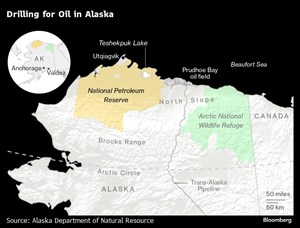Biden administration plans “sweeping” effort to block oil and gas exploration in Alaska
(Bloomberg) – The U.S. set aside 23 million acres of Alaska’s North Slope to serve as an emergency oil supply a century ago. Now, President Joe Biden is moving to block oil and gas development across roughly half of it.
The initiative, set to be finalized within days, marks one of the most sweeping efforts yet by Biden to limit oil and gas exploration on federal lands. It comes as he seeks to boost land conservation and fight climate change — and is campaigning for a second term on promises to do more of it.
The changes wouldn’t affect ConocoPhillips’s 600 MMbbl Willow oil project in the National Petroleum Reserve-Alaska. But oil industry leaders say the plan is more expansive than initially anticipated and threatens to make it nearly impossible to build more important projects in the region.
That’s spooking oil companies with holdings in the National Petroleum Reserve, which — along with the rest of Alaska’s North Slope — was viewed as a major growth engine for the industry before the shale boom. Interest has surged again in recent years, fed by huge, significant discoveries. Tapping the region’s reservoirs could yield decades of production.
Company executives and Alaska lawmakers have increasingly raised alarm over the plan, saying it could thwart oil and gas development across much of the reserve, even on existing leases. The opposition has united a broad spectrum of foes, from Alaska Natives to lower-48 oil producers.
Santos Ltd., which leases more than a million acres within the reserve and is developing the nearby Pikka Unit joint venture with Repsol SA, said in a filing with the Bureau of Land Management that the proposal would infringe on its holdings, with impacts “as extensive as whole projects being denied.”
ConocoPhillips, which has 156 leases in the reserve, warned the regulation would violate its contracts and “drive investment away from the NPR-A.” And Armstrong Oil & Gas Inc., whose leases there span 1.1 million gross acres, said the measure could block it from building the infrastructure needed to access those tracts.
The proposed rule would effectively nationalize the company’s leases, Chief Executive Officer Bill Armstrong told White House officials in a March 21 meeting, according to people familiar with the discussion. A company spokesman declined to comment on the matter.
The regulation would limit future oil development in some 13 million acres (20,000 square miles) of designated “special areas” within the Indiana-sized reserve, including territory currently under lease. There’d be an outright prohibition on new leasing in 10.6 million acres.
The proposal would create a formal program for expanding protected areas at least once every five years — while making it difficult to undo those designations. And it would raise the bar for future development elsewhere in the reserve.
The Interior Department said in a preamble the regulation wouldn’t affect existing leases. But the proposed rule text doesn’t offer similar, explicit assurance. Instead, it proposes to give the government broad authority to limit or bar access to existing leases, “regardless of any existing authorization.”
Oil leasing and infrastructure development would be presumed not to be permitted unless specific information clearly demonstrates the work can be done with “no or minimal adverse effects” on the habitat.
The Interior Department says the proposal would not have a significant effect on the nation’s energy supply. Still, the reserve could be a notable source of fuel, with the rock formations beneath it holding an estimated 8.7 Bbbl of recoverable oil, according to a 2017 assessment by the US Geological Survey.
Enthusiasm for the region picked up after recent discoveries in the Nanushuk field, and the state of Alaska expects crude production from the reserve to climb from 15,800 bpd in fiscal 2023 to 139,600 bpd in fiscal 2033.
Opponents say the plan would shift the role of the reserve to conservation instead of oil development, contrary to congressional intent. “The current statute says that the primary purpose is to increase domestic oil supply as expeditiously as possible,” said Kara Moriarty, president of the Alaska Oil and Gas Association. “But the rule takes a completely different premise.”



